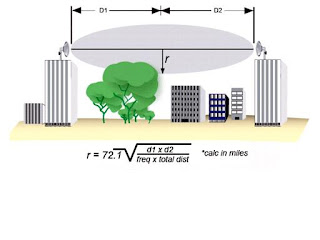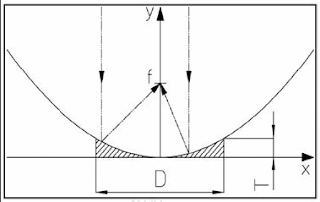A parabola can be used to concentrate radiation from an antenna located at its focus to form a beam in the same way that a searchlight reflector produces a light beam. The reflector creates a large surface area that the antenna uses to receive and transmit signals like the wireless booster. This type of antenna is a unidirectional antenna, meaning that is transmits in one specific direction.
The Primestar is an oblong shaped parabolic reflector that is a high gain, low cost surplus or possibly free dish with an offset feed (offset in order to be out of the way of the incoming signal). Attach a coffee can antenna as the offset feed horn to your Primestar. Mount the entire anntenna securely to make sure it doesn't move. (Note to hams: a cheap motorized rotator from an older satellite TV dish could be fitted on the end of the feed horn boom-arm to rotate your home-brew feed horn for optimal polarization.) If you're using a solid parabolic grid antenna and live in an area where high winds are common, you may want to consider replacing it with a mesh dish in order to prevent potential wind damage.
According to Martin, the biquad antenna is "easy to build", and provides a reliable 11dBi gain, with a fairly wide beamwidth. A parabolic antenna will give you good range for your signal, however, they are more challenging to aim correctly due to the fact that they have a narrow beamwidth and signals arrive and exit at an angle. Dish antennas are mostly used for a point to point system for long haul systems. Plug in your numbers at Parabolic Reflector Analysis to view gain and beamwidth. Determining the focal length of a parabolic dish and Calculating a Parabolic Dish’s focal point are useful.
Here are instructions for a Primestar dish biquad feed. There is a European Dish version. Engadget's biquad version has plenty of pictures. Check out the simple modification using a US standard aluminum soda can!
Cheap USB WiFi adapters, icon in conjunction with reflective parabolic cookware (woks, steamers, sieves etc., can offer a cost effective alternative
* The USB Wifi adapters can readily be mounted at the focal point of suitable parabolic reflectors.
* All the signal decoding is done right in the USB Wifi adapter, so no cable losses occur.
* USB Wifi adapters are cheap, although their power output may be low.
* Regular cheap USB extension cables & connectors can be used.
* Easily swaps out for testing assorted reflectors & adaptors.
* Gains of 1~12dB at minimal cost can extend line of site (LOS) ranges to several km.
F(ocus)/D(iameter) ratio desirability is 0.25-0.55 for a shallow parabola. For example if you have a 300mm (12in) diameter, 60mm depth to center diameter.The strainer/steamer reflector doesn't have the numbers. This 8dBi directional USB wireless-g adapter dish antenna is a better choice for many people.
For Australians there is Eric's Mod for an Austar 2.195GHz MDS dipole and antenna. Step-by-step of parabolic reflector template for a wireless router antenna.
Roof Mounts
It's important to consider antenna grounding and lightning protection for tower and roof mounted antennas. For a tower, there should be a good ground wire attached between the tower base and earth ground. For roof-mounts, the mast should be grounded to the steel structure of the building. Alternatively, run a large diameter wire from the mast directly to earth ground. Lightning protectrs should be added to the coax cable between the antenna and the wireless access point.
 The Fresnel Zone is the area around the visual line-of-sight that radio waves spread out into after they leave the antenna. You want a clear line of sight to maintain signal strength, especially for 2.4 GHz wireless systems. This is because 2.4 GHz waves are absorbed by water, like the water found in trees.
The Fresnel Zone is the area around the visual line-of-sight that radio waves spread out into after they leave the antenna. You want a clear line of sight to maintain signal strength, especially for 2.4 GHz wireless systems. This is because 2.4 GHz waves are absorbed by water, like the water found in trees.
The Primestar is an oblong shaped parabolic reflector that is a high gain, low cost surplus or possibly free dish with an offset feed (offset in order to be out of the way of the incoming signal). Attach a coffee can antenna as the offset feed horn to your Primestar. Mount the entire anntenna securely to make sure it doesn't move. (Note to hams: a cheap motorized rotator from an older satellite TV dish could be fitted on the end of the feed horn boom-arm to rotate your home-brew feed horn for optimal polarization.) If you're using a solid parabolic grid antenna and live in an area where high winds are common, you may want to consider replacing it with a mesh dish in order to prevent potential wind damage.
According to Martin, the biquad antenna is "easy to build", and provides a reliable 11dBi gain, with a fairly wide beamwidth. A parabolic antenna will give you good range for your signal, however, they are more challenging to aim correctly due to the fact that they have a narrow beamwidth and signals arrive and exit at an angle. Dish antennas are mostly used for a point to point system for long haul systems. Plug in your numbers at Parabolic Reflector Analysis to view gain and beamwidth. Determining the focal length of a parabolic dish and Calculating a Parabolic Dish’s focal point are useful.
Here are instructions for a Primestar dish biquad feed. There is a European Dish version. Engadget's biquad version has plenty of pictures. Check out the simple modification using a US standard aluminum soda can!
Cheap USB WiFi adapters, icon in conjunction with reflective parabolic cookware (woks, steamers, sieves etc., can offer a cost effective alternative
* The USB Wifi adapters can readily be mounted at the focal point of suitable parabolic reflectors.
* All the signal decoding is done right in the USB Wifi adapter, so no cable losses occur.
* USB Wifi adapters are cheap, although their power output may be low.
* Regular cheap USB extension cables & connectors can be used.
* Easily swaps out for testing assorted reflectors & adaptors.
* Gains of 1~12dB at minimal cost can extend line of site (LOS) ranges to several km.
F(ocus)/D(iameter) ratio desirability is 0.25-0.55 for a shallow parabola. For example if you have a 300mm (12in) diameter, 60mm depth to center diameter.The strainer/steamer reflector doesn't have the numbers. This 8dBi directional USB wireless-g adapter dish antenna is a better choice for many people.
For Australians there is Eric's Mod for an Austar 2.195GHz MDS dipole and antenna. Step-by-step of parabolic reflector template for a wireless router antenna.
Roof Mounts
It's important to consider antenna grounding and lightning protection for tower and roof mounted antennas. For a tower, there should be a good ground wire attached between the tower base and earth ground. For roof-mounts, the mast should be grounded to the steel structure of the building. Alternatively, run a large diameter wire from the mast directly to earth ground. Lightning protectrs should be added to the coax cable between the antenna and the wireless access point.
 The Fresnel Zone is the area around the visual line-of-sight that radio waves spread out into after they leave the antenna. You want a clear line of sight to maintain signal strength, especially for 2.4 GHz wireless systems. This is because 2.4 GHz waves are absorbed by water, like the water found in trees.
The Fresnel Zone is the area around the visual line-of-sight that radio waves spread out into after they leave the antenna. You want a clear line of sight to maintain signal strength, especially for 2.4 GHz wireless systems. This is because 2.4 GHz waves are absorbed by water, like the water found in trees.


0 comments:
Post a Comment